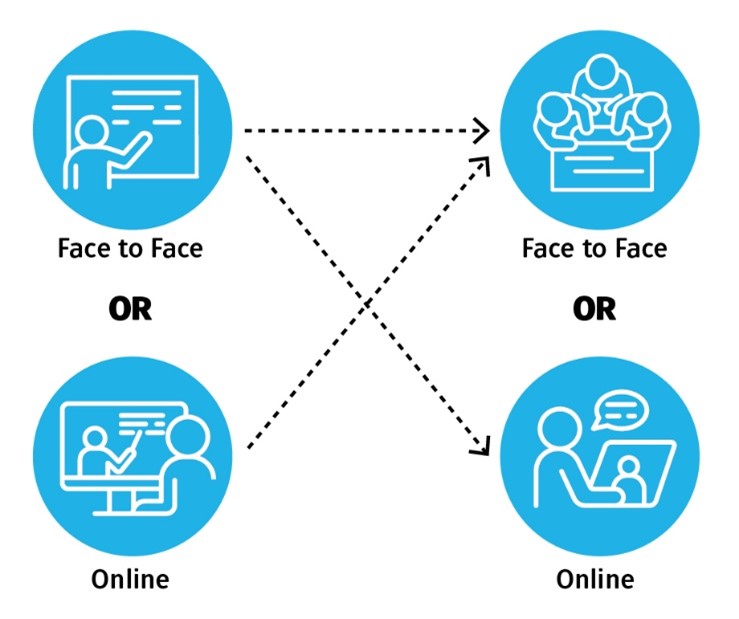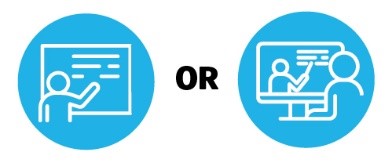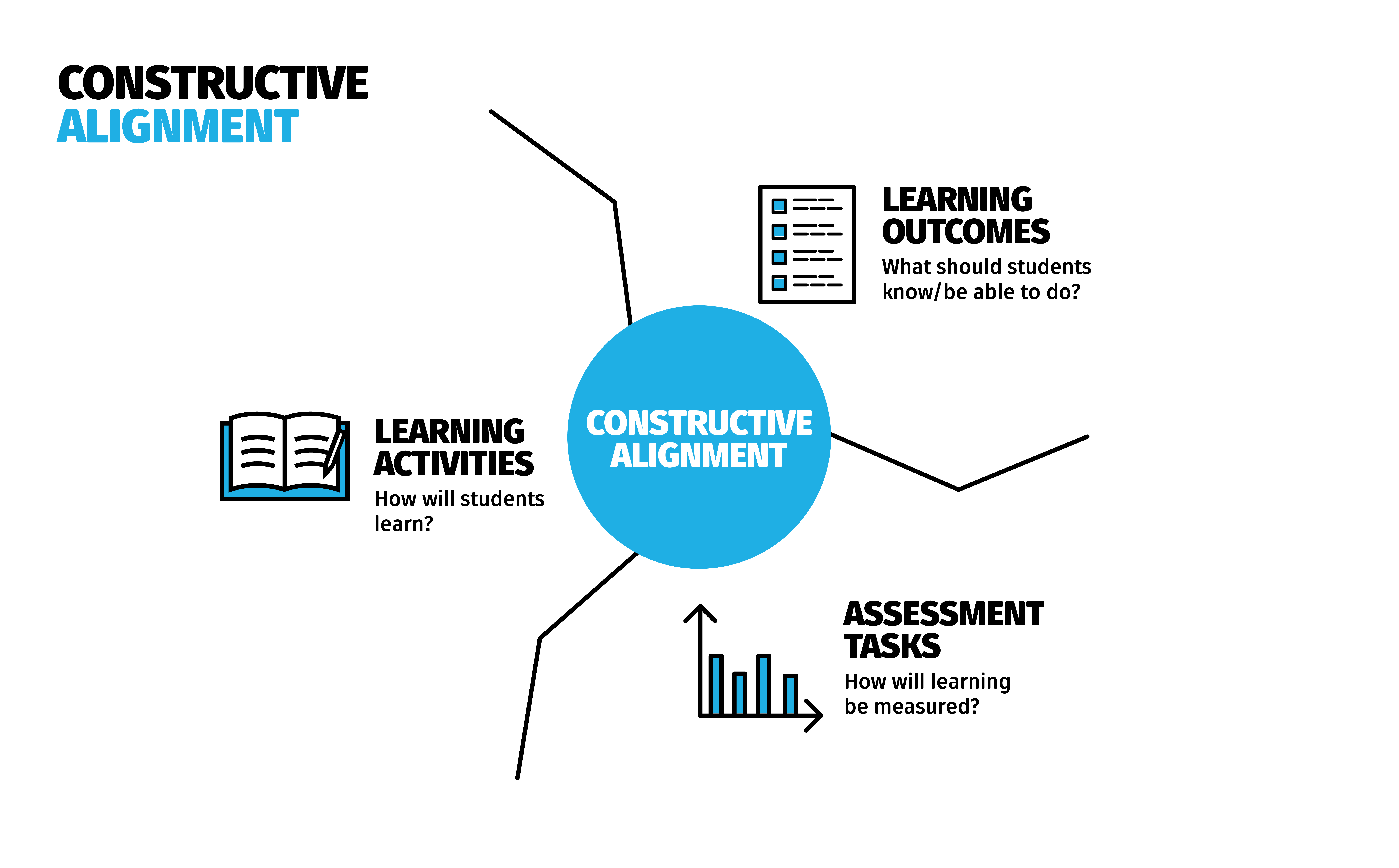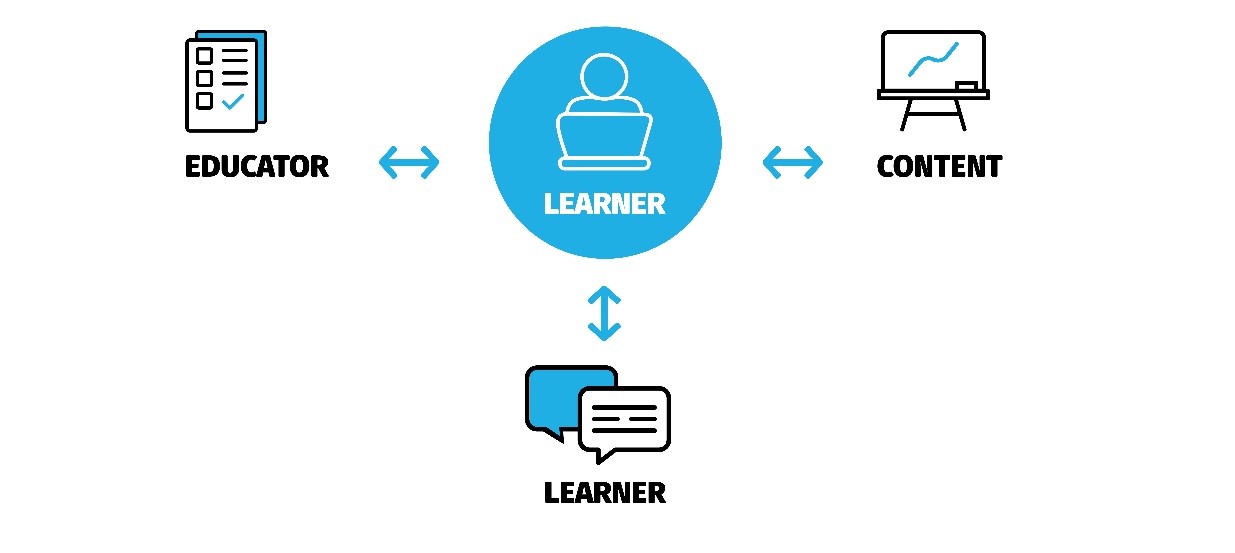
Teaching and research
COURSE DELIVERY MODE
On Campus Simultaneous
 | ||
CONTENT DELIVERYStudents attend on campus lectures/lectorials OR participate | ACTIVE LEARNINGStudents attend on campus labs, | |
In a typical Simultaneous course Educators deliver content in person during scheduled sessions (e.g. lectures) This delivery of content is supported by weekly timetabled in-person active learning sessions (e.g. Labs, tutorials, workshops). These are focused on review and reinforcement of content, and application of knowledge and concepts.
All sessions (content delivery and active learning) can be access live online, simultaneously with the in person delivery.
Students have flexibility to participate each week either in person or online but must attend at least one face to face session each week.
| Description | In Person Attendance (Physical space required) | Timetabled Component | |
|---|---|---|---|
Content Delivery
| Content is delivered on campus through educator-led lectures/lectorials. These sessions are available simultaneously online. | Flexible |
|
Active Learning | Students attend timetabled in person sessions (e.g. tutorials, labs, workshops, etc) that focus on educator-led application of knowledge and concepts. These sessions are available simultaneously online. | Flexible |
|
Students must attend at least one in person session (either content delivery or active learning). Teaching space and course delivery must be appropriate for high quality simultaneous online participation.
The highly flexible nature of simultaneous delivery affords students some of the benefits of both Online and Face to Face delivery modes. Being able to participate either online or in-person allows students to tailor their study around unexpected competing priorities each week.
The requirement for at least weekly in person participation will contribute to maintaining relationships and connections.
A version of simultaneous delivery can be beneficial when courses are delivered across multiple locations. It may be appropriate to deliver in person lectures at one location while allowing students enrolled at a second location to participate online.
While simultaneous delivery does offer students great flexibility, it may also be considered one of the most difficult modes of delivery to implement to a high standard. Several factors must be considered:
- Appropriate Space: Simultaneous courses must be scheduled in teaching spaces that have appropriate technology that allows high quality remote participation and engagement.
- Educator Proficiency: Educators must be proficient in both using the technology required for simultaneous delivery, but also in delivering to in person and online cohorts at the same time.
- Planning and Course Design: Educational experiences must be carefully planned to ensure that students can participate effectively both in person and online. This may be relatively straight forward for traditional content delivery lectures but will require significant effort for any more interactive sessions.
- Variable attendance: The flexibilityfor students to chooses their preferred attendance method, and vary that week to week, means that predicting student attendance and timetabling appropriate spaces can be difficult.
- Additional Administration: Maintaining records of which students attended which in-person session each week may be difficult.
Regardless of the mode of delivery, ensuring constructive alignment should be a primary focus of any course design work. Constructive alignment is a design approach that ensures alignment between learning outcomes, teaching methods, and assessments, fostering meaningful learning by connecting these elements in a coherent and purposeful way.
What should you consider when designing a Simultaneous delivery:
- Technology & Space Requirements: Ensure that both in-person and remote participants have access to the necessary technology and resources to engage effectively in the course. Consider the hardware, software, internet connectivity, and compatibility requirements for seamless participation.
- Communication Channels: Establish clear communication channels and protocols to facilitate interaction and engagement between in-person and remote participants. Utilize tools like chat platforms in Zoom, discussion forums, or video conferencing to promote collaboration, Q&A sessions, and group work.
- Active Learning Strategies: Incorporate active learning strategies that promote engagement and interaction among all participants. This could include group discussions, case studies, problem-solving activities, collaboration with peers, or virtual breakout sessions that facilitate active participation regardless of location.
- Weekly Learning Outcomes: Clearly express what your students should be able to achieve by the end of each week, how the teaching and learning activities will contribute to these outcomes, and how weekly learning outcomes align with and contribute to the overall course learning outcomes.
- Collaborative Learning: Encourage collaborative learning experiences by incorporating group activities and projects that require students to work together. This fosters teamwork, communication skills, and deeper understanding through peer interaction.
- Reflection and Evaluation: Incorporate opportunities for students to reflect on their learning experiences and evaluate their progress. Encourage self-assessment, peer feedback, and facilitate class discussions. Also consciously plan to reflect on your own teaching practices throughout the semester.
Learning Design and Teaching Innovation can assist using our Course Design Toolkit.
- Course Introduction: A well thought out, welcoming, clear and structured introduction in the course site can go a long way to ensuring that your expectations of learners are well understood. It can also help minimise the time needed to address administrative questions during the first few weeks of term.
- Clear Navigation and Organisation: Ensure that the Canvas site is well-organized. Use a logical modular structure that is intuitive for students to navigate. Use simple statements to outline your expectations of students for each week/module. Do your students know what they need to do this week? What do they need to do before, and after, the in-person/online simultaneous session?
- Incorporate Pre-Class Activities: Use the Canvas site to provide pre-class resources that can help students prepare for in person/online simultaneous sessions. This could include pre-reading materials, videos, quizzes, or discussion prompts that introduce key concepts or stimulate thinking prior to in person/online simultaneous interactions. Explain how these activities contribute to the weekly learning outcomes, and how you will build on these activities in your face to face sessions.
- Incorporate Post-Class Activities: Incorporate post-class activities on the Canvas site to reinforce and extend learning beyond the in-person sessions. These activities could include reflection exercises, online discussions, follow-up readings, or additional assignments that encourage students to apply and consolidate their learning.
- Discussion boards, announcements, and reminders. Clearly articulate how you will utilise Canvas communication channels within your course and use these consistently. Encourage students to participate in these discussions by posing thoughtful questions, sharing relevant resources, or providing prompts for reflection and peer interaction.
- Digital Content Accessibility: Ensure that all digital content provided through Canvas is accessible to all students. Consider providing alternative formats for text-based content, such as transcripts for videos or audio recordings, and adopt digital practices when creating learning materials that meet accessibility guidelines.
Interactive learning activities promote active learning and engagement through three types of interaction: learner-content, learner-educator, and learner-learner. That is, your students should be given opportunities to explore a concept from different angles.
SIMULTANEOUS

Learner-Educator |
|
Learner-Learner  |
|
Learner-Content  |
|
All learner activities for Simultaneous courses must be carefully planned to ensure that students can engage in a high-quality equivalent experience regardless of whether they are participating in-person or online.
- Simultaneous Teaching
- Using YouTube - What you need to know
- All Active Learning Resources
- Controlling your nerves
- TEQSA Guideance Notes and Good Practice Hub
- Quality Matters: Top Tips for Designing a HyFlex Course
- Service Now Knowledge Base - Zoom in teaching: FAQs
- Service Now Knowledge Base: - Using Zoom in a teaching space with a Zoom Room
The University of Newcastle acknowledges the traditional custodians of the lands within our footprint areas: Awabakal, Darkinjung, Biripai, Worimi, Wonnarua, and Eora Nations. We also pay respect to the wisdom of our Elders past and present.